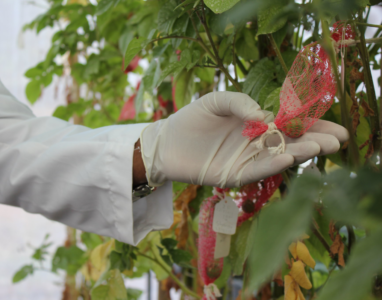
As increasingly erratic weather, pest and disease expansion, and other trends threaten farmers’ ability to produce enough food for the growing population, crop breeders are working on ways to speed up and improve the development of more resilient, high-yielding varieties. The current COVID-19 pandemic only reinforces the urgency of developing and disseminating superior crop varieties that can improve smallholders’ food security and production for markets. Potato and sweetpotato breeders with the International Potato Center (CIP) are rising to this challenge by renovating their approach to crop improvement through a new breeding strategy.
“Given the increasing challenges that smallholders face and recent advances in scientific knowledge and technologies, the time is ripe for us to rethink how we want to conduct breeding in the years to come, and what we want to deliver to farmers,” said Hugo Campos, CIP’s Director of Research.
Campos noted that CIP’s potato and sweetpotato breeding programs have had an enormous impact on food and nutrition security and livelihoods in the Global South over the past five decades by contributing hundreds of improved varieties released by national partners that are grown by millions of farmers. But evolving markets and climate change mean that CIP and its partners need to accelerate the breeding process, and ensure widespread adoption by developing varieties with the characteristics that farmers and consumers want.
CIP began working on a new breeding strategy in late February, when potato and sweetpotato breeders from four continents met in Holland. That meeting also included experts from industry, leading universities and other research centers who provided a range of critical perspectives and experience. They discussed issues that included how to streamline breeding operations, orient them toward market demands, and strengthen the links between breeding programs and genebanks. The resulting proposals are being woven into a new strategy that should be completed by May.

This process is closely aligned with a broader effort to improve breeding across the CGIAR, led by the CGIAR Excellence in Breeding Platform (EiB). Experts from EiB have led trainings for CIP scientists in new tools and approaches to enhance breeding effectiveness, and they have conducted evaluations of CIP’s breeding programs that have already resulted in improvements.
Hannele Lindqvist-Kreuze, who leads CIP’s crop improvement division, explained that breeders are already using tools promoted by EiB, such as the elaboration of product profiles to guide the development of new varieties.
“For years, breeders focused on broad agro-ecologies, developing varieties that produced well in a region but often lacked important characteristics that farmers or consumers wanted,” she said. “We now aim to breed for specific markets, to produce potato and sweetpotato varieties that meet local needs and preferences.”
“Our breeding programs will become much more end-user driven than in the past,” said Campos. “The rate at which genetic progress is made towards novel varieties will be accelerated, and the adoption of these cultivars by smallholders will increase.”
